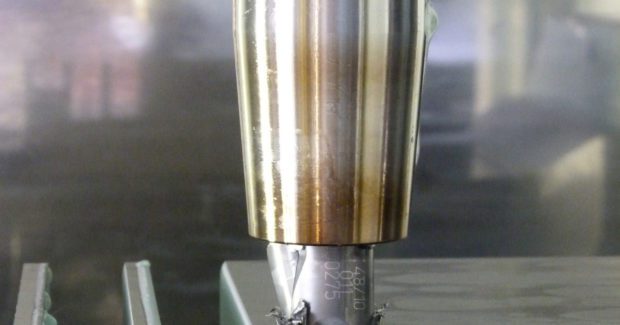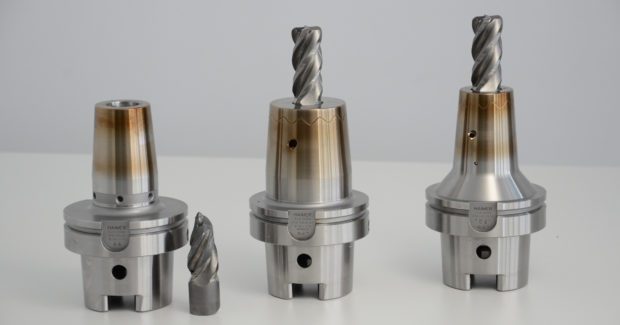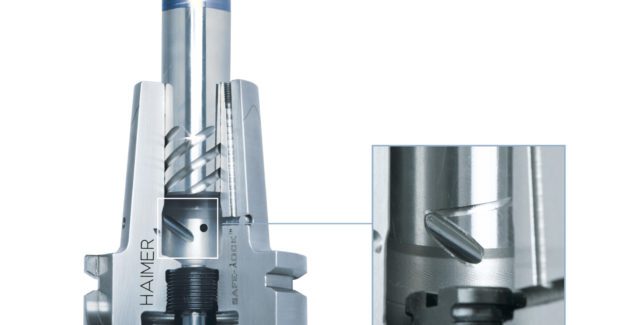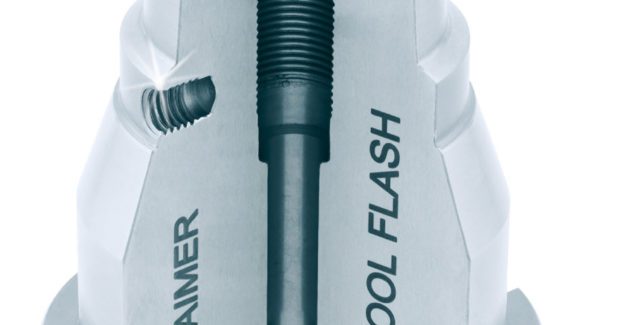Safe Heavy Duty Machining of Difficult Materials
The importance of the tool holder is still understated in roughing and heavy duty machining, where metal removal rates are absolutely crucial for productivity. But now, using special shrink fit chucks with drive pins and spiral grooves in the tool shank, it is possible to perform high-feed full slotting up to 2xD (50 mm) or more in difficult to machine materials.
Posted: September 1, 2016
"I consider the Safe-Lock system to be a practical, easy to handle and process reliable addition to the shrinking technology that we already utilize, especially in connection with standardized tools of other manufacturers."
In the aerospace, energy and mechanical engineering sectors, production managers must bridge the gap between economic efficiency and high process reliability when working with materials that are difficult to machine. Fortunately there is peace of mind in knowing that machine technology innovations continue to develop to meet these ongoing demands. Heller Machine Tools GmbH (Nuertingen, Germany) is known as a source of inspiration for these kinds of innovations in their 4-axis and 5-axis CNC machining centers, CNC mill/turning centers, CNC machines for crankshaft and camshaft machining, as well as flexible manufacturing systems. Shops value their availability of products and their competency in managing special processing demands. Both qualities stem from Heller’s in-house manufacturing, which relies on closer collaboration with customers, suppliers and research institutes to remain on the forefront of innovation.
ROUGHING IS A HIGHLY PROMISING PROCESS
“Our service includes optimizing the machining processes together with our customers and suppliers,” explains Werner Kirsten of the Technology Development Department at Heller. He is responsible for the area of “difficult to machine materials. “To support such services with practical trials, our Technology Center is equipped with a variety of machines.” In most cases, the aim is to increase the productivity without compromising the process reliability. “We often achieve this aim with an optimized roughing operation which ultimately results in a reduced finishing process,” adds Kirsten. “By maintaining the same technological values but shortening the finishing depth of cut by 50 percent, the overall machining time is reduced to half. However, this requires process reliable and controllable systems during roughing.”
This means all machining components in the process chain must be considered to improve productivity. The machine tool is the most evident component of the machining process, but the tool, the tool holding system, the coolant supply and other elements are also essential for a successful operation. “In the end, the weakest link of the process chain limits the success,” states Kirsten. He doesn’t believe most machine shops pay attention to the tool holder, even though it is especially significant for high performance cutting. “Many of the trials we’ve carried out during the last few years have proven this point,” he explains. “We realized that the tool holder has an incredible influence on the machining process. In the case of reinforced shrink fit chucks, for example, the vibration node is closer to the bearing point (due to the larger mass). The result is a smoother machining process with less vibration and a better surface finish quality while using the same tool, machine, process parameters and fixturing technology.”
TOOL HOLDING: AN IMPORTANT FACTOR FOR PRODUCTIVITY
By selecting the right tool holder, good productivity and surface quality results can be achieved using basic standard cutting tools. Kirsten refers to comparative tests with basic four-edge cutting tools without an inner coolant supply. As an alternative to a standard shrink fit chuck he selected a Power Shrink Chuck with Cool Flash from Haimer GmbH (Igenhausen, Germany) that ensures the coolant is transported directly to the cutting edges. “Compared to using a normal shrink fit chuck and external coolant, we were able to achieve significantly better results,” he says.
GAINING NEW INSIGHTS FROM DIFFICULT CASES
When a group of representatives from the aerospace industry, the Technical University of Dortmund and Technical University of Hamburg-Harburg visited Heller, an especially extensive milling application study was conducted in Titanium Ti-6AI-4V. The available machining center was a 4-axis H 5000 with a gear unit and HSK-A100 spindle that yields torques up to 2.290 Nm.
In order to demonstrate the machining potential, different 25 mm diameter end mills were used to mill full slots into a titanium plate. To simulate holder conditions used in aerospace
applications, the tools were clamped into reinforced shrink fit chucks. At an axial cutting depth of 0.5xD to 1.0xD the machining process was found to be very reliable. Since the spindle was not running at full capacity, the trial participants agreed to increase full slottingdepth to 2xD. “Under these conditions the tool pulled out of the shrink fit chuck during the machining operation, creating a slot closer to 2.5xD as it progressed through the part,” recalls Kirsten. “Towards the end of the slot the tool finally broke as a result of increased cutting forces.”
The milling specialists all agreed that the clamping force of the chuck was the limiting factor in this process. As soon as the axial pressure and process related vibrations become too high, the tool moves out of the chuck and further into the workpiece. At the same time the cutting pressure increases such that the tool breaks and the workpiece is irreversibly damaged. Reasons and possible countermeasures were discussed intensively. In the end, Kirsten developed the idea that the tools are forced to navigate towards the spindle when the holding forces are exceeded. This is how he ultimately noticed the patented Safe-Lock™ system from Haimer which, in addition to frictional clamping forces, has the same helix pattern as the tool. Theoretically, Kirsten realized that even if the tool got loose while using Safe Lock, it would be pulled into the holder through the helical drive keys and not into the part. A movement that can be easily prevented through the use of length presetting screws.
PREVENT TOOL PULL-OUT
Kirsten got in contact with Haimer to test the Safe-Lock system. “We wanted to know if our ideas could be put into practice using their system in an even less forgiving environment,” he says. The Heller technology developer repeated the same trial as before with a few major changes. Safe-Lock grooves were subsequently added on similar solid carbide tools, but the application would be run again with a reduced spindle taper interface (HSK 63 instead of HSK 100), with a less rigid 5-axis gear driven spindle, and a less stable diagonally-fixtured workpiece. Despite these additional limiting factors, the tool was able to process a full slot of 2xD = 50 mm with complete process reliability. “We were able to indirectly prove that Safe-Lock works and that the shrinking technology has even more potential with HSK-A100, especially on 5-axis machining centers withgear spindles,” notes Kirsten.
Afterwards, this sample machining on Ti-6AI-4V was carried out at various times, including during the Airshow in Farnborough where it was proven that the previous limit of 1xD = 25 mm full slotting in titanium could be doubled with the use of Safe-Lock. “For roughing operations, this is a reliable process,” summarizes Kirsten. “I consider the Safe-Lock system a practical, easy to handle and process reliable addition to the shrinking technology that we already utilize, especially in connection with standardized tools of other manufacturers.”
From the onset of its creation, Haimer recognized the incredible potential of the Safe-Lock system and created a licensing program to give innovative tool manufacturers the ability to integrate the patented pull-out protection system into their tools. The result of this vision to create a more open system has been a tremendous success, with 14 leading cutting tool manufacturers having now signed licensing agreements, including Walter, Widia, Sandvik Coromant, Seco Tools, Sumitomo, Kennametal, Helical, Emuge Franken, Data Flute, Niagara, OSG, Melin, SGS Tools and Mapal.
Through the steady increase of Safe-Lock tooling in the market via Haimer and its licensed partners, the system has become a new standard for heavy machining and roughing. In fact, its popularity and simplicity is replacing the old Weldon clamping system, particularly when new milling strategies such as trochoidal (dynamic) milling are involved. “With our Safe-Lock system we found a solution that combines a high runout accuracy with 100 percent pullout protection,” explains Andreas Haimer, the president of Haimer Group. “This system has successfully established itself as a standard in the aerospace industry and, generally speaking, for roughing and heavy duty machining. Now more companies that make use of the trochoidal (dynamic) milling strategy are also making the switch to Safe-Lock for a good reason.”
During trochoidal milling operations, where the cutting speed and axial depth of cut can be increased through software support, productivity is significantly improved. However, the increased cutter engagement and cutting forces that result from the higher cutting performance create a situation where tool-pullout can occur very easily. Prior to Safe-Lock, this problem was prevented with Weldon shanks and chucks. However, shops had to sacrifice speed and accuracy due to the nature of this clamping system. A shrink fit chuck with Safe-Lock offers the same safety as the Weldon system, but provides the additional advantage of accuracy and balance. The ideal of balancing and runout characteristics of the shrinking technology combined with the clamping safety of the Safe-Lock system permit greater productivity that is achieved through faster permissible speeds and increased tool life – all with complete tool security assurance.
Haimer USA, LLC, 134 E. Hill Street, Villa Park, IL 60181, 630-833-1500, Fax: 630-833-1507, [email protected], www.haimer-usa.com.
Haimer GmbH, Weiherstr.21, Igenhausen, Germany 86568, +49 (0) 82 57 / 99 88-0, Fax: +49 8257 1850, [email protected], www.haimer.de.



















